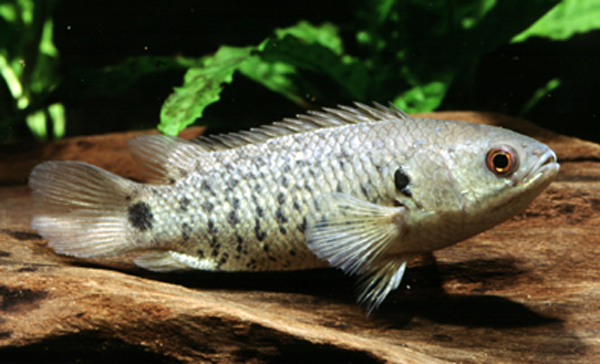| Anabantidae (Climbing gouramies) |
| 25 cm TL (male/unsexed) |
|
demersal; depth range - 0 m, potamodromous |
| Asia: India to Wallace line including China. May have been distributed in more areas than were commonly reported. |
|
Dorsal spines (total): 16-20; Dorsal soft rays (total): 7-10; Anal spines: 9-11; Anal soft rays: 8-11. Color in life dark to pale greenish, very pale below, back dusky to olive; head with longitudinal stripes ventrally; posterior margin of opercle with a dark spot; iris golden reddish. Body form variable, affected by age and amount of food consumed. Scaled head with 4-5 rows between eye and rear margin of preoperculum. Scales large and regularly arranged, ciliate. |
| Found mostly in canals, lakes, ponds, swamps and estuaries (Ref. 41236, 57235). Adults occur in medium to large rivers, brooks, flooded fields and stagnant water bodies including sluggish flowing canals (Ref. 12975). Often found in areas with dense vegetation (Ref. 12693). Can tolerate extremely unfavorable water conditions and is associated mainly with turbid, stagnant waters (Ref. 6028). They remain buried under the mud during dry season (Ref. 1479). Feed on macrophytic vegetation, shrimps and fish fry (Ref. 6028). Reported to undertake lateral migration from the Mekong mainstream, or other permanent water bodies, to flooded areas during the flood season and return to the permanent water bodies at the onset of the dry season (Ref. 37770). During the dry season, they stay in pools associated with submerged woods and shrubs (Ref. 37770). Posses an accessory air-breathing organ (Ref. 2847). Able to survive for several days or weeks out of water if the air breathing organs can be kept moist (Ref. 1479). Quite famous for its ability to walk; important food fish in SE Asia, considered as a tasty food fish (Ref. 6565) but not of the finest quality since it is bony (Ref. 2686). Usually sold live in markets where it is kept alive for several days by keeping it moist (Ref. 12693). Economic foodfish in the Southeast Asia (Ref. 57235). |
|
Data deficient
(Ref. 96402)
|
| harmless |
|
Source and more info: www.fishbase.org. For personal, classroom, and other internal use only. Not for publication.
Page created by Jen, 05.08.02,
php script by kbanasihan 06/09/2010 ,
last modified by
dsantos, 20/08/10

